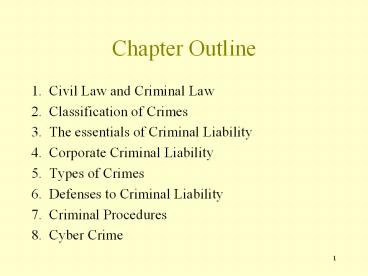Chapter Outline PowerPoint PPT Presentation
1 / 17
Title: Chapter Outline
1
Chapter Outline
- 1. Civil Law and Criminal Law
- 2. Classification of Crimes
- 3. The essentials of Criminal Liability
- 4. Corporate Criminal Liability
- 5. Types of Crimes
- 6. Defenses to Criminal Liability
- 7. Criminal Procedures
- 8. Cyber Crime
2
1 Civil and Criminal Law
- Major differences
Civil (Tort) Criminal
Preponderance Beyond Reasonable Doubt
Damages Jail or Prison
Private (parties hire their own attorneys) Public (Prosecutor represents community)
3
2 Classification of Crimes
- An act can have both civil and criminal
consequences. (O.J. Simpson trials)
Felonies Misdemeanors
Serious crimes, punishable by Death or prison for more than one (1) year. Non-serious (petty) crimes punishable by jail for less than one(1) year and/or by fines.
4
3 Essentials of Criminal Liability
- To be convicted of a crime, a person must
- Commit a guilty act (actus reus).
- Have the guilty mind (mens rea) during
commission of the guilty act.
5
4 Corporate Criminal Liability
- A corporation is creature of state statute.
- A corporate entity may be convicted of a crime.
- Punishment would be fines and/or denial of
certain legal privileges.
6
Liability of Corporate Entity
- Corporations may be convicted of criminal
activity if - Crime is within agent/employees scope of
employment - Corporation fails to perform a legally required
duty or - Crime authorized or requested by corporate
principal/officer.
7
Liability of Corporate Officers
- Corporate officers and directors are personally
liable for crimes they commit. - Also, they may be criminally liable for acts of
their under the Responsible Corporate Officer
doctrine. U.S. v. Park (1975). - Case U.S. v. Hanousek (1999).
8
5 Types of Crimes
- Violent Crimes (aka Crimes Against Persons).
- Murder, sexual assault, rape, robbery.
- Property Crimes.
- Burglary, larceny, theft of trade secrets, theft
of services, arson, receipt of stolen goods,
forgery.
9
White Collar Crimes
- Crimes occurring in the business context using
non-violent means to obtain personal or business
advantage. - Embezzlement.
- Mail or Wire Fraud (federal).
- Bribery.
- Bankruptcy Fraud (federal).
- Insider Trading (federal).
- Theft of Trade Secrets (federal).
10
6 Defenses to Criminal Liability
- Infancy (juvenile).
- Involuntary Intoxication is a defense if person
was incapable of understanding act. - Insanity defendant lacked substantial capacity
to appreciate the wrongfulness of act or to
conform act to law. - Mistake.
- Duress.
- Consent.
11
Defenses 2
- Self-Defense of People and Property use deadly
force if reasonable belief of immanent death or
serious injury cannot use deadly force to
protect property alone. - Necessity criminal act necessary to prevent
greater harm.
12
Defenses 3
- Entrapment prevents government from encouraging
crimes. Key issue was the defendant
pre-disposed to commit the act? - Statute of Limitations.
- Immunity.
13
7 Criminal Procedures
- U.S. Constitution provides specific safeguards
for those accused of crimes at federal and state
level. - Criminal procedures are designed to protect
against the arbitrary use of power by the
government. - Case People v. McFarlan (2002).
14
Fourth Amendment
- The Fourth Amendment protects against
unreasonable search and seizures. - No warrant for search or arrest can issue without
probable cause.
15
Exclusionary Rule
- Evidence obtained in violation of Constitutional
amendments is excluded from trial. - Deter police from warrantless searches, seizures
and misconduct. - Inevitability and good faith are exceptions
to the rule.
16
The Miranda Rule
- Case Miranda v. Arizona (1966) required
police to inform suspects of their constitutional
rights. - The Supreme Court upheld Miranda in Dickerson v.
U.S. (2000).
17
Criminal Process

